DENVER — WildEarth Guardians (WEG) and the Prairie Dog Coalition of the Humane Society of the United States this week released a tool for communities interested in creating prairie dog management plans, preventing conflict, and conserving these keystone species.
The guide covers everything from prairie dog ecology, to the role of state and federal agencies in conserving prairie dogs, to the components of a conservation plan. It also covers barrier installation and best practices for relocation. The guide is intended for local governments and stakeholders.
“Prairie dogs are a key part of the prairie ecosystem,” said Taylor Jones, endangered species advocate for WildEarth Guardians. “This guide provides communities with the tools they need to protect wildlife and wild lands by protecting prairie dogs.”
“For years, concerned citizens and wildlife managers have asked for a next step to manage prairie dogs to reduce conflict and offer non-lethal options. This is that document,” said Lindsey Sterling Krank, director of the Prairie Dog Coalition of the Humane Society of the United States. “We were fortunate to have assistance from Pam Wanek, who is a fourth generation Coloradoan and prairie dog expert who contributed significantly to the work.”
Prairie dogs are one of the most controversial and widely misunderstood native wildlife species in North America.
Since early European migration onto the North American grasslands, prairie dogs have been celebrated as an essential keystone species for healthy grasslands ecosystems, but also vilified and in some locations managed as destructive rodent pests. Human-caused threats stemming from crop agriculture, livestock grazing, energy development, residential and commercial development, prairie dog shooting, poisoning campaigns and plague (an introduced disease) have caused the five species of prairie dogs to disappear from an estimated 87 to 99 percent of their historic range, depending on the species.
Prairie dogs are a key species to nine other species, such as hawks, owls, foxes and ferrets, and many others depend on prairie dogs for food, or their burrows for shelter. “If we want all these Great Plains species to survive, we need healthy prairie dog populations,” Jones said.
Since most species of prairie dog are not protected under federal or state law, local communities can play an important role in prairie dog conservation by including prairie dogs in their planning processes. The guide introduces many options for non-lethal management, including advanced planning, development agreements, barrier installation and relocation.
“Every acre of prairie dog towns conserved is a win for these social and intelligent animals,” concluded Jones.

